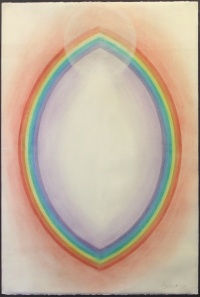Mandorla: Difference between revisions
(Created page with "The mandorla is an ancient symbol with several meanings. It is often used to depict the human aura or the womb. == History == == Mandorla in sacred geometry == The ''Vesica...") |
No edit summary |
||
| Line 10: | Line 10: | ||
The ''Vesica Piscis'' is a special version of the mandorla. Author Gregg Braden says, | The ''Vesica Piscis'' is a special version of the mandorla. Author Gregg Braden says, | ||
<blockquote>As two perfect spheres are formed overlapping one another by half (each contains half the diamter of the other), a zone of commonality is created in the overlap. In the science of Sacred Geometry, this zone is referred to as the ''Vesica Piscis''. The form of the ''vesica'' was used as both the Egyptian glyph for the "mouth" as well as for the Creator. Additionally, this glyph is also very similar to the Mayan glyph for zero, associated with our | <blockquote>As two perfect spheres are formed overlapping one another by half (each contains half the diamter of the other), a zone of commonality is created in the overlap. In the science of Sacred Geometry, this zone is referred to as the ''Vesica Piscis''. The form of the ''vesica'' was used as both the Egyptian glyph for the "mouth" as well as for the Creator. Additionally, this glyph is also very similar to the Mayan glyph for zero, associated with our galaxy of the Milky Way.<ref>Gregg Braden, ''Awakening to Zero Point: The Collective Initiation'' (Bellevue, WA: Radio Bookstore Press, 1997), 195.</ref></blockquote> | ||
== Mandorla in Theosophical art == | == Mandorla in Theosophical art == | ||
Theosophist Burton Callicott created several renditions of the mandorla form. Two examples are in the art collection of the | Theosophist [[Burton Callicott]] created several renditions of the mandorla form. Two examples are in the art collection of the Theosophical Society in America: [[Mandorla (art work)|''Mandorla'']] and [[Mandorla No. 12 (art work)|''Mandorla No. 12'']] | ||
[[File:Callicott Mandorla 1.jpg|right|200px| | |||
[[File:Callicott Mandorla 1.jpg|right|200px|''Mandorla'' by Burton Callicott, 2000.]] | |||
Revision as of 04:19, 30 January 2012
The mandorla is an ancient symbol with several meanings. It is often used to depict the human aura or the womb.
History
Mandorla in sacred geometry
The Vesica Piscis is a special version of the mandorla. Author Gregg Braden says,
As two perfect spheres are formed overlapping one another by half (each contains half the diamter of the other), a zone of commonality is created in the overlap. In the science of Sacred Geometry, this zone is referred to as the Vesica Piscis. The form of the vesica was used as both the Egyptian glyph for the "mouth" as well as for the Creator. Additionally, this glyph is also very similar to the Mayan glyph for zero, associated with our galaxy of the Milky Way.[1]
Mandorla in Theosophical art
Theosophist Burton Callicott created several renditions of the mandorla form. Two examples are in the art collection of the Theosophical Society in America: Mandorla and Mandorla No. 12
Notes
- ↑ Gregg Braden, Awakening to Zero Point: The Collective Initiation (Bellevue, WA: Radio Bookstore Press, 1997), 195.
